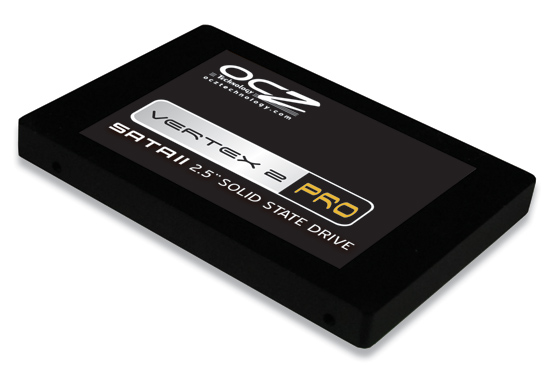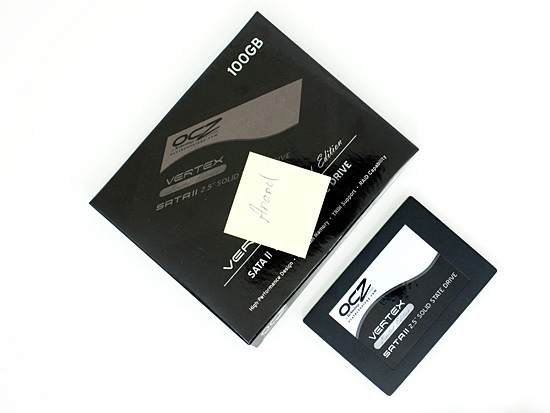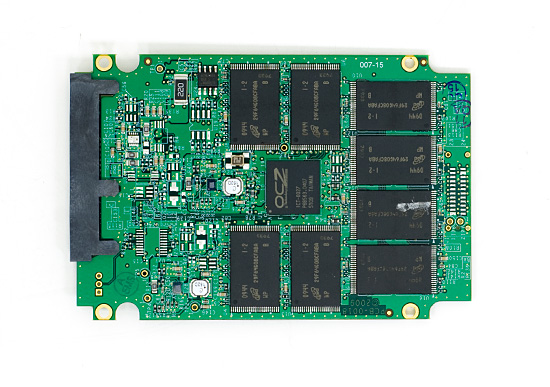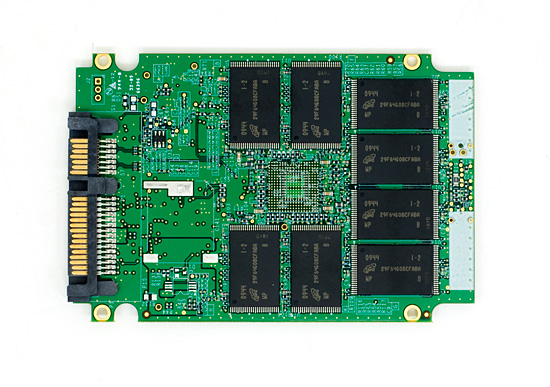OCZ’s Vertex Limited Edition Review & SSD State of the Union
by Anand Lal Shimpi on February 19, 2010 12:00 AM EST- Posted in
- Storage
Back in December I previewed OCZ’s Vertex 2 Pro, the first drive I’d tested to use SandForce’s SF-1500 controller. As you may remember, the controller works in a radical way - by reducing the amount of data written to flash it improves performance and longevity, at the cost of controller/firmware complexity. Not a bad tradeoff for a company trying to sell you expensive SSD controllers. If you want to know more about how it works, I'd suggest consulting my Vertex 2 Pro Preview. If you want to know how SSDs work, take a look at the SSD Relapse.

RIP...
The drive made an impressive showing, easily besting any other MLC SSD I’d ever tested. Unfortunately, it was pre-release hardware, with no known price and no set release date. Not to mention that the company who made the controller was shipping largely unproven technology with an unknown amount of reliability/validation testing.
Since then two things have happened.
First, my SandForce SF-1500 pre-release sample straight up died on me. No warning, no errors, just no data. It only took a couple of weeks worth of real world use to make it happen, but this is why I prefaced the preview with the following:
“Ultimately, the task of putting these drives to the test falls on the heads of you all - the early adopters. It’s only after we collectively put these drives through hundreds and thousands of hours of real world usage that we can determine whether or not they’re sponge-worthy. Even Intel managed to screw up two firmware releases and they do more in-house validation than any company I’ve ever worked with. The bugs of course never appeared in my testing, but only in the field in the hands of paying customers. I hate that it has to be this way, but we live in the wild west of solid state storage. It’ll be a while before you can embrace any new product with confidence.
And it only gets more complicated from here on out. The old JMicron drives were easy to cast aside. They behaved like jerks when you tried to use them. Now the true difference between SSDs rears its head after months or years of use.”
And second, the OCZ Vertex 2 Pro as a product has been canned. Not because of the issue that lead to the untimely death of my drive, but because the SF-1500 controller is just too expensive. I knew that it was going to be pricey at the time I wrote the article, but apparently OCZ thought it could bring the price down by the time it shipped. Needless to say, that didn’t happen.
Instead of the Vertex 2 Pro, OCZ will be shipping the regular Vertex 2 based on SandForce’s slower SF-1200 controller. This SSD will carry a pricetag similar to present day Vertex drives, but hopefully offer better performance. For enterprise customers OCZ will ship the Vertex 2 EX based on the SF-1500 with SLC flash and a ginormous, quarterly-budget depleting pricetag (to be determined). The consumer MLC SF-1500 based Vertex 2 Pro is gone forever.
Here’s where the Vertex Limited Edition comes in:

Despite its name, the Vertex Limited Edition is an MLC SandForce SF-1500 SSD (technically it's a SF-1200/SF-1500 hybrid like the Vertex 2 Pro, but that's a separate issue entirely). It's basically the Vertex 2 Pro with one big caveat - there are only a limited number of these drives being made - 5,000 to be exact. Once they're all gone, that's it.

My Vertex LE is Serial #1. Ebay, here I come!
OCZ apparently got a sweetheart deal on an early batch of SF-1500s. This is the same controller from the Vertex 2 Pro in December, but with an updated firmware (RC1). These are the first drives shipping with RC1 of the SF-1500 firmware and will presumably not die on you after a couple of weeks. While I’ve heard that they may not be enterprise worthy, they are apparently fit for desktop use. OCZ has said that in its internal testing there haven't been any cases of a bricked Vertex LE. The same was not true during the Vertex 2 Pro test period. Now here comes the problem.

The OCZ Vertex Limited Edition. That's a SandForce SF-1500 controller under that OCZ logo in the middle.
I literally just received my drive 24 hours ago. Just like its ancestor, this thing will be put through the wringer for the coming weeks and months. However long it takes to make sure it is worthy of your dollars. The problem is that these drives are limited in quantity, chances are they will all be gone by the time I figure out whether or not they are worthy of a glowing recommendation.
What makes the Limited Edition so special is that because of OCZ’s great pricing on the SF-1500 the 100GB Vertex LE will be selling for $399 ($829 for the 200GB version) - roughly the same price as a 128GB Indilinx based Vertex drive. And in case you’re wondering, yes it performs identically to the Vertex 2 Pro I previewed last year:
| OCZ Vertex LE 100GB | OCZ Vertex 2 Pro 100GB | |
| 4KB Random Write | 51.2 MB/s | 50.9 MB/s |
| 2MB Sequential Write | 252.7 MB/s | 252.0 MB/s |
| 4KB Random Read | 52.0 MB/s | 51.3 MB/s |
| 2MB Sequential Read | 265.3 MB/s | 265.3 MB/s |
| PCMark Vantage Overall | 16827 | 16767 |
| PCMark Vantage HDD | 39288 | 39970 |
| AT Bench - Light | 884 IOPS | 890 IOPS |
| AT Bench - Heavy | 701 IOPS | 705 IOPS |
| AT Bench - Gaming | 319 IOPS | 319 IOPS |
For roughly the same price per GB you’d pay for an Intel X25-M G2, you’re getting a much faster drive. The only issue is that its reliability is unproven. To calm your fears, OCZ is selling the Vertex LE with a 3 year warranty.

Barring any unforeseen issues, the drives will go on sale next week. Risky business.
I should note that we’ve seen vendors get quite opportunistic with hot SSDs in limited quantities before. There’s always the chance that these Vertex LEs will sell for more than their MSRP.
The nifty OCZ Toolbox I showed in my Vertex 2 Pro preview presently doesn’t work with the Vertex LE. The application looks for SandForce in the controller id, which is absent from these unbranded SF-1500 controllers that SandForce unloaded. By the time the drives ship though there should be a custom version of the OCZ Toolbox ready. TRIM is supported and works perfectly under Windows 7.
Unlike the Vertex 2 Pro sample I tested, the Vertex LE doesn’t have the ungodly expensive capacitor on its PCB. As I mentioned before, these aren’t designed to go into servers and thus the supercap won’t be missed. Performance on the drive is great and I haven’t had any issues thus far in my testing, but there’s a long road ahead of me.
The RC1 firmware is brand new to me. I’ll be putting the drive through its paces but given that the units will go on sale next week I decided to share my initial thoughts today rather than wait.










83 Comments
View All Comments
allessd - Saturday, February 20, 2010 - link
maybe this site is of interest to you:"SSD Decoder Ring - an SSD comparison guide"
www.pcper.com/article.php?aid=736
Jupie - Saturday, February 20, 2010 - link
Great article - always nice to hear about SSDs as I clearly see them as the future for a boot drive at least.What I'm curious about is the performance of drives of the same series with different capacities. I'm not willing to spend ~800 USD on a drive but rather ~400 USD. How much performance hit does a Real SSD C300 really take? Manufactors clearly seem to prefer to send their biggest drives with the highest performance to test but what about the performance of the reasonalbe priced ~100 GB versions?
Would be great to read about that as well ;o)
Otherwise keep up the good articles!
MadMan007 - Saturday, February 20, 2010 - link
Yeah this is an important point, it applies to regular HDs to a much lesser extent too. I would like to see tests on smaller capacity drives of a given series. I guess a lot depends on implentation, for example using the same number of flash chips with a given controller just of a lower capacity per chip versus using fewer flash chips and channels.Conscript - Friday, February 19, 2010 - link
Not sure why I'd pay the premium for "limited" SF-1500 drives when I can just get the same thing here, for less...http://eshop.macsales.com/shop/internal_storage/Me...">http://eshop.macsales.com/shop/internal_storage/Me...
Anand, any chance you think they'd give you one for review? Thinking about putting one of these in my new MBP (when they come out). Unless the new MBP has SATA 3, in which case I might look hard at the C300.
iwodo - Friday, February 19, 2010 - link
May be Anand can do an article on that. You mention previously that controller contribute VERY little to the total cost of SSD. NAND being the major part.If that is the case, then assuming we always need 8 chips for an SSD. SSD Prices wont ever dropped below $100? Because while capacity per unit will grow, it seems minimum unit prices dont fall that much.
icrf - Saturday, February 20, 2010 - link
Yeah, I'd love to see a reliable, slow 8-16 GB drive for $50. I've got a RAID server that can't seem to keep up boot drives and would love something like that.Bolas - Friday, February 19, 2010 - link
So if I'm willing to spend up to $1200 for a boot drive, what's the best option? Crucial? Vertex LE? Intel? OCZ Z-Drive? Something else?czesiu - Friday, February 19, 2010 - link
Any chances for a Kingston SNV425 review?mckirkus - Friday, February 19, 2010 - link
I would like to see what pure RAM drive based storage would do so we can get a sense of how close these drives are getting to some sort of maximum.I'm not sure if you can do this with a RAMDisk you create with software or if and entire image would need to run in RAM (HDTach, etc., will not work on RAM drives for some reason. Just to be clear, I'm not referring to benchmarks of RAM using a SATA interface.
Good stuff yet again Anand.
mindless1 - Friday, February 19, 2010 - link
There is no "sort of maximum", DRAM keeps getting faster.However, if you were to create and use a RAMDISK, however you ended up doing so, it would destroy any flash drive in terms of performance on every possible parameter. The question is not about performance at all, rather the implementation and volatile nature of using it... and of course that it's no small feat to end up with hundreds of GB worth of those chips for typical HDD replacement purposes (in a reasonably sized form factor).